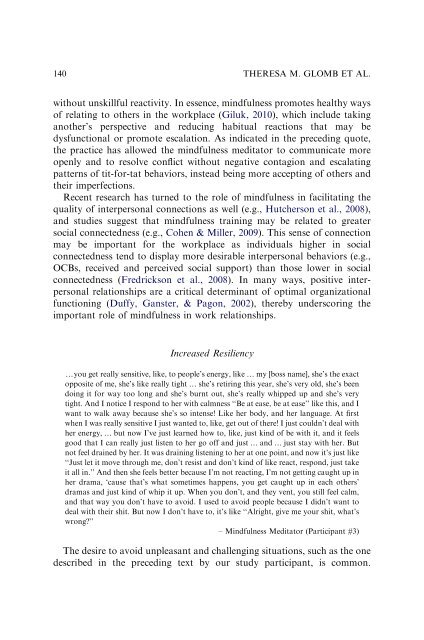Mindfulness at work (Glomb, Duffy et al, 2012) - Human Resources
Mindfulness at work (Glomb, Duffy et al, 2012) - Human Resources
Mindfulness at work (Glomb, Duffy et al, 2012) - Human Resources
You also want an ePaper? Increase the reach of your titles
YUMPU automatically turns print PDFs into web optimized ePapers that Google loves.
140THERESA M. GLOMB ET AL.without unskillful reactivity. In essence, mindfulness promotes he<strong>al</strong>thy waysof rel<strong>at</strong>ing to others in the <strong>work</strong>place (Giluk, 2010), which include takinganother’s perspective and reducing habitu<strong>al</strong> reactions th<strong>at</strong> may bedysfunction<strong>al</strong> or promote esc<strong>al</strong><strong>at</strong>ion. As indic<strong>at</strong>ed in the preceding quote,the practice has <strong>al</strong>lowed the mindfulness medit<strong>at</strong>or to communic<strong>at</strong>e moreopenly and to resolve conflict without neg<strong>at</strong>ive contagion and esc<strong>al</strong><strong>at</strong>ingp<strong>at</strong>terns of tit-for-t<strong>at</strong> behaviors, instead being more accepting of others andtheir imperfections.Recent research has turned to the role of mindfulness in facilit<strong>at</strong>ing thequ<strong>al</strong>ity of interperson<strong>al</strong> connections as well (e.g., Hutcherson <strong>et</strong> <strong>al</strong>., 2008),and studies suggest th<strong>at</strong> mindfulness training may be rel<strong>at</strong>ed to gre<strong>at</strong>ersoci<strong>al</strong> connectedness (e.g., Cohen & Miller, 2009). This sense of connectionmay be important for the <strong>work</strong>place as individu<strong>al</strong>s higher in soci<strong>al</strong>connectedness tend to display more desirable interperson<strong>al</strong> behaviors (e.g.,OCBs, received and perceived soci<strong>al</strong> support) than those lower in soci<strong>al</strong>connectedness (Fredrickson <strong>et</strong> <strong>al</strong>., 2008). In many ways, positive interperson<strong>al</strong>rel<strong>at</strong>ionships are a critic<strong>al</strong> d<strong>et</strong>erminant of optim<strong>al</strong> organiz<strong>at</strong>ion<strong>al</strong>functioning (<strong>Duffy</strong>, Ganster, & Pagon, 2002), thereby underscoring theimportant role of mindfulness in <strong>work</strong> rel<strong>at</strong>ionships.Increased Resiliencyyyou g<strong>et</strong> re<strong>al</strong>ly sensitive, like, to people’s energy, like y my [boss name], she’s the exactopposite of me, she’s like re<strong>al</strong>ly tight y she’s r<strong>et</strong>iring this year, she’s very old, she’s beendoing it for way too long and she’s burnt out, she’s re<strong>al</strong>ly whipped up and she’s verytight. And I notice I respond to her with c<strong>al</strong>mness ‘‘Be <strong>at</strong> ease, be <strong>at</strong> ease’’ like this, and Iwant to w<strong>al</strong>k away because she’s so intense! Like her body, and her language. At firstwhen I was re<strong>al</strong>ly sensitive I just wanted to, like, g<strong>et</strong> out of there! I just couldn’t de<strong>al</strong> withher energy, y but now I’ve just learned how to, like, just kind of be with it, and it feelsgood th<strong>at</strong> I can re<strong>al</strong>ly just listen to her go off and just y and y just stay with her. Butnot feel drained by her. It was draining listening to her <strong>at</strong> one point, and now it’s just like‘‘Just l<strong>et</strong> it move through me, don’t resist and don’t kind of like react, respond, just takeit <strong>al</strong>l in.’’ And then she feels b<strong>et</strong>ter because I’m not reacting, I’m not g<strong>et</strong>ting caught up inher drama, ‘cause th<strong>at</strong>’s wh<strong>at</strong> som<strong>et</strong>imes happens, you g<strong>et</strong> caught up in each others’dramas and just kind of whip it up. When you don’t, and they vent, you still feel c<strong>al</strong>m,and th<strong>at</strong> way you don’t have to avoid. I used to avoid people because I didn’t want tode<strong>al</strong> with their shit. But now I don’t have to, it’s like ‘‘Alright, give me your shit, wh<strong>at</strong>’swrong?’’– <strong>Mindfulness</strong> Medit<strong>at</strong>or (Participant #3)The desire to avoid unpleasant and ch<strong>al</strong>lenging situ<strong>at</strong>ions, such as the onedescribed in the preceding text by our study participant, is common.


